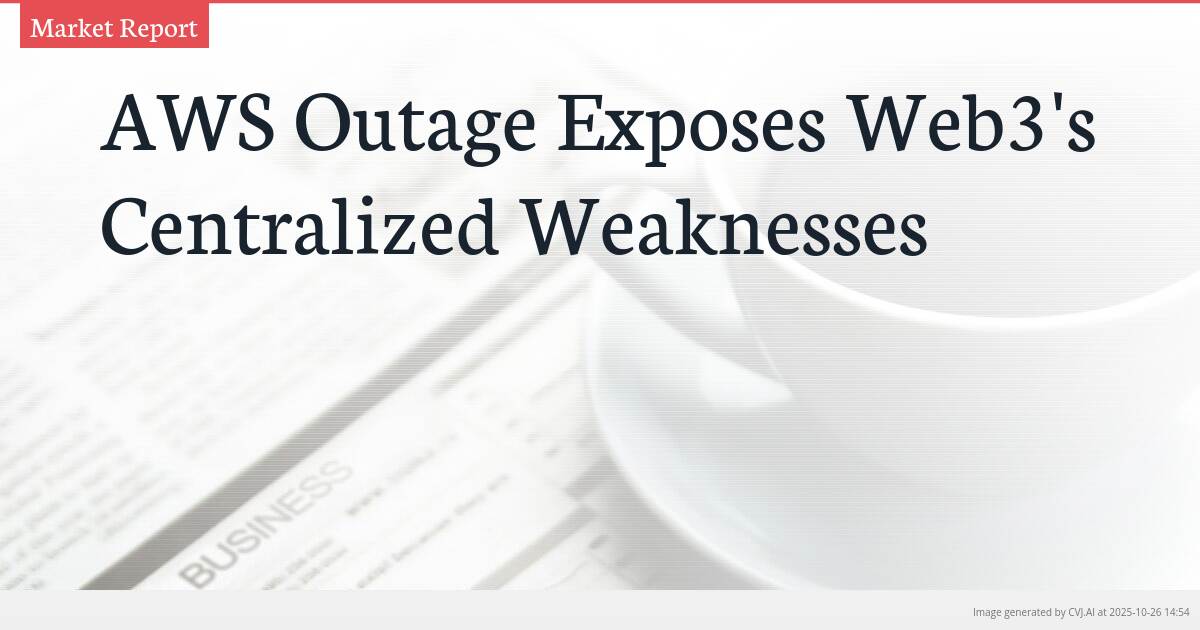This summary text is fully AI-generated and may therefore contain errors or be incomplete.
Introduction
A 15-hour Amazon Web Services outage that crippled major crypto platforms including Coinbase, Robinhood, and MetaMask has exposed fundamental vulnerabilities in Web3’s infrastructure. While blockchain networks continued operating normally, millions of users were locked out of their digital assets and applications, revealing that true decentralization remains elusive beyond the ledger layer and highlighting the ecosystem’s dangerous dependence on centralized cloud servers.
Key Points
- Major crypto platforms including Coinbase and Robinhood were inaccessible for 15 hours due to AWS server failures
- Blockchain networks continued producing blocks uninterrupted, but user access was blocked by centralized infrastructure dependencies
- Industry experts emphasize the need to diversify beyond hyperscale providers to community-driven distributed networks for true Web3 resilience
The Infrastructure Breakdown
The recent Amazon Web Services outage served as a stark reminder of Web3’s hidden centralization problem. For 15 hours, major cryptocurrency and fintech platforms including Coinbase, Robinhood, MetaMask, and Venmo experienced widespread service disruptions that prevented users from accessing their wallets, executing trades, or interacting with decentralized applications. The irony was palpable: while blockchain networks themselves continued producing blocks uninterrupted, the gateways and interfaces that millions depend on for access were completely disabled by a single point of failure in centralized infrastructure.
This incident exposed the critical gap between Web3’s decentralized ideals and its practical implementation. The very platforms that champion decentralization as their core philosophy found themselves paralyzed by their reliance on Amazon Web Services, one of the world’s largest centralized cloud providers. The outage affected not just trading platforms but also wallet services like MetaMask, demonstrating how deeply embedded these centralized dependencies have become throughout the crypto ecosystem.
The Decentralization Paradox
Jamie Elkaleh, chief marketing officer at Bitget Wallet, articulated the core issue to Cointelegraph: ‘Decentralization has succeeded at the ledger layer but not yet at the infrastructure layer.’ This statement captures the fundamental paradox facing Web3 today. Blockchain technology itself provides remarkable resilience through distributed consensus mechanisms, yet the applications built on top of these networks often rely on the same centralized infrastructure that Web3 proponents seek to replace.
The disruption affected decentralized applications (DApps) across multiple sectors, from trading platforms like Coinbase and Robinhood to payment services like Venmo. These services, while interacting with decentralized networks, maintained their user interfaces, application programming interfaces (APIs), and critical backend services on Amazon Web Services servers. When AWS experienced downtime, these supposedly decentralized services became completely inaccessible, undermining their core value proposition of censorship resistance and continuous availability.
Path to True Resilience
The AWS outage has sparked urgent conversations about building more robust infrastructure for the Web3 ecosystem. As Elkaleh emphasized, ‘Real resilience depends on diversifying beyond hyperscalers into community-driven and distributed networks.’ This call to action highlights the need for the industry to develop infrastructure solutions that match the decentralized nature of the underlying blockchain technology.
Moving forward, the industry faces the challenge of developing truly decentralized alternatives to current cloud infrastructure. This may involve distributed hosting solutions, peer-to-peer networking protocols, and community-operated node networks that can provide the same level of reliability without the single points of failure inherent in hyperscale cloud providers. The 15-hour disruption served as an expensive lesson in infrastructure risk management, demonstrating that dependence on any single provider, no matter how reliable, creates systemic vulnerability.
The incident has created renewed momentum for infrastructure decentralization initiatives. As the Web3 ecosystem matures, the focus must expand beyond blockchain consensus mechanisms to include the entire technology stack. Only by addressing these infrastructure dependencies can the promise of true decentralization—resilient, censorship-resistant, and continuously available digital services—be fully realized.
📎 Read the original article on cointelegraph.com

